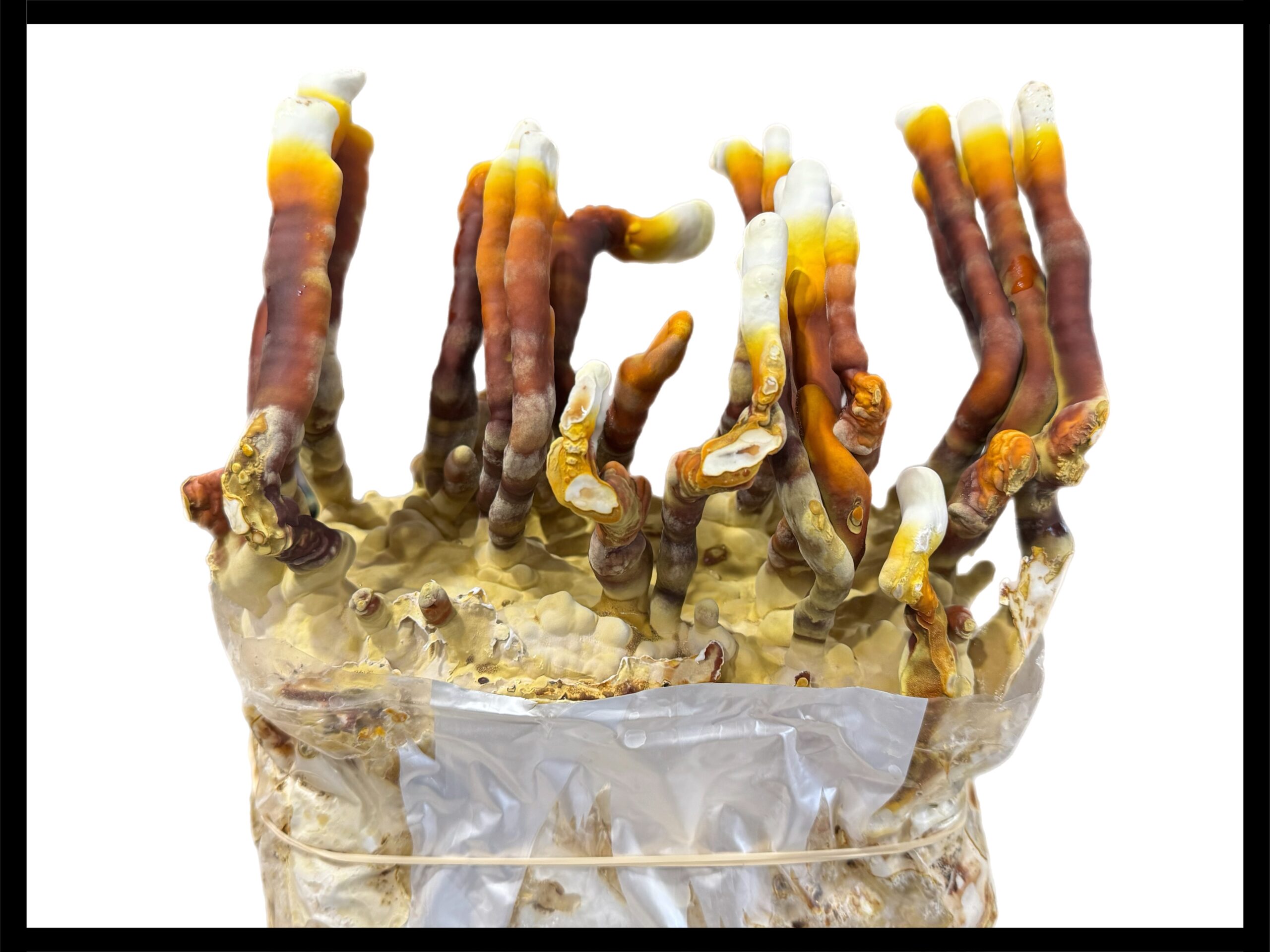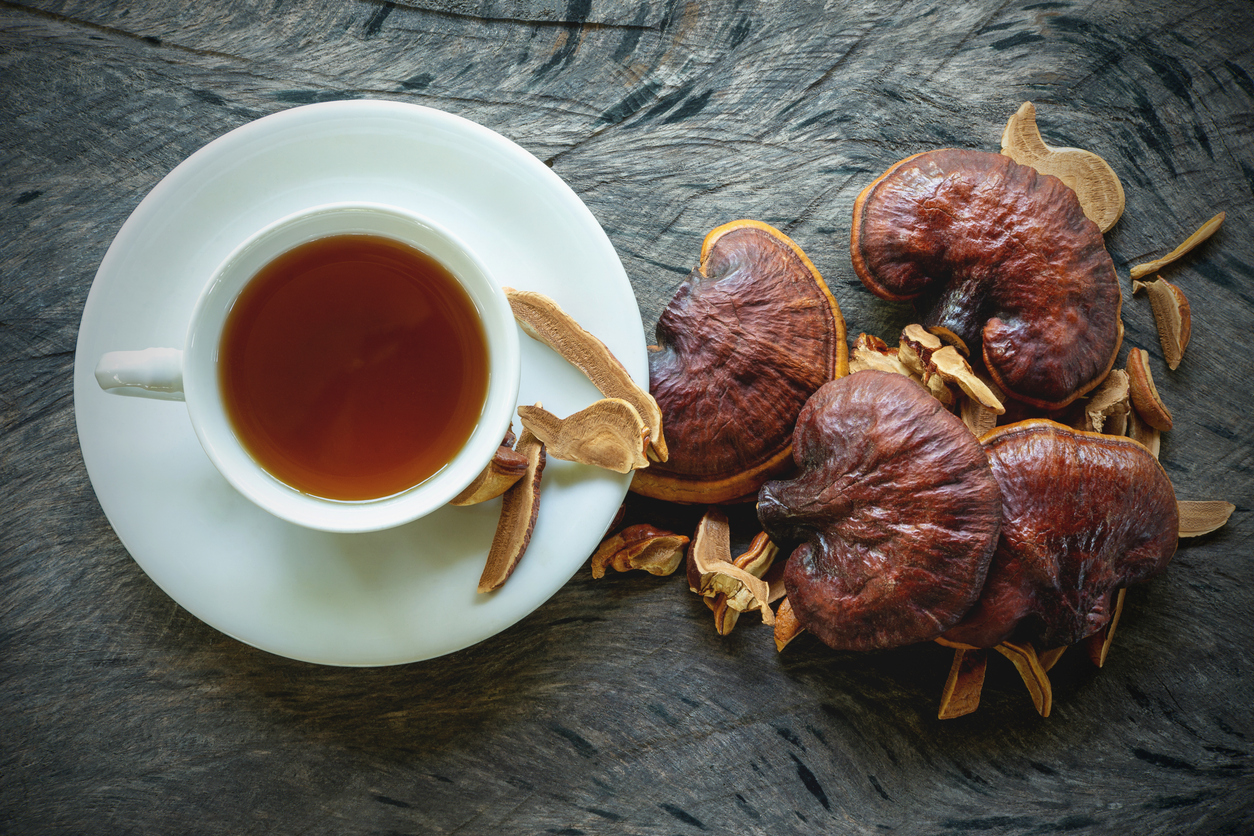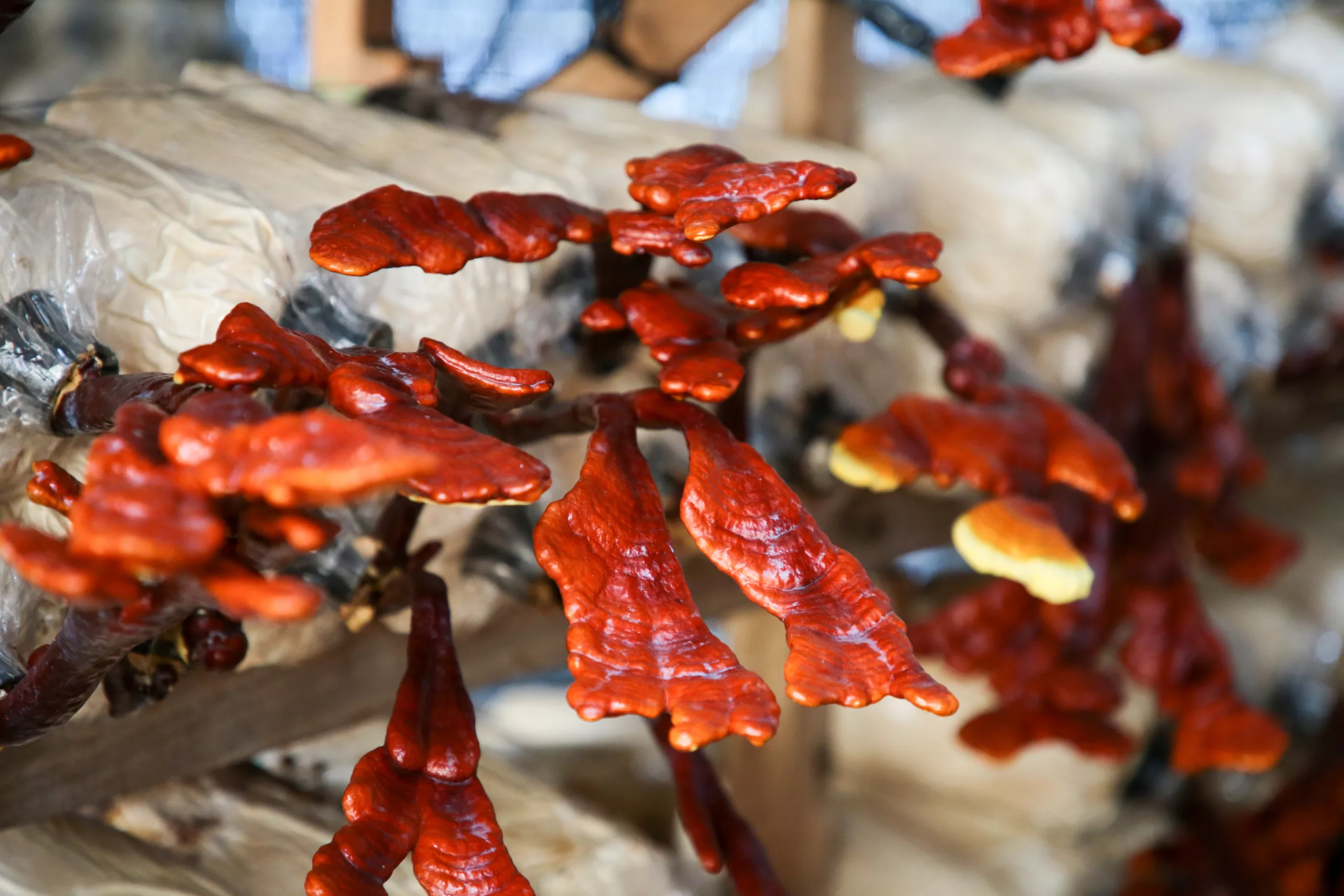Reishi, along with the entire Ganoderma Genus, is prized for its health benefits, and is among the most unique-looking fungi in our collection. In this article, we’ll discuss some of the health benefits of Reishi mushrooms and Ganoderma as a whole. We’ll also discuss the genetic lineage of Ganoderma as a genus, as well as its fungal group, polypores. Learn what makes this genus unique, and you may even want to pick up some spore syringes to continue learning about the captivating world of mycology.
Reishi Mushroom Benefits
Ganoderma Lucidum is a commonly foraged mushroom and supplement throughout China, Japan, and Korea. Traditional uses for Ganoderma date back to at least 2,000 years ago, but it remains highly relevant today, and boasts a thriving industry of products sold throughout Asia. Medicines come in many forms such as powders and extracts for consumption, lotions for external use, and medications such as Ganoderma-based polysaccharide extracts. 
Reishi is used to treat many conditions, but it is especially useful for aiding immunity. Reishi can improve the function of lymphocytes, or white blood cells, and can even increase the number of white blood cells, which can help the body fight infections. This can be especially helpful for improving quality of life for people fighting cancer. Although further research is needed, Reishi’s anti-inflammatory properties can even help fight cancer, potentially killing certain types of cancer cells or slowing their growth.
People suffering with fatigue, irritability, and general discomfort may also benefit from Reishi supplementation, with promising studies showing that eight weeks of Reishi supplementation can ease these symptoms.
What are Polypores?
Polypores are a type of gilled mushroom that often form a shelf-like shape. They can often be found growing on the side of trees, or on decaying wood. Often tough and woody in texture, many polypores are not edible, at least not in the way we typically think of eating mushrooms, but they have been used throughout human history in teas and in powdered form for their medicinal benefits. Ötzi the Iceman, a mummified man who lived between 3350 and 3105 BC, was discovered in the Austrian Alps carrying two species of polypore fungi: presumably for both medicinal purposes, and to be used as kindling.
Many polypores grow in a semicircular shape on the side of the tree trunk it grows from, forming a rounded, shelf-like shape in their environment. Instead of dispersing their spores from gills as typical mushrooms do, polypores release mushroom spores from numerous “pinholes” on their undersides. If you can’t see these holes with the naked eye, you should be able to see them with a magnifying glass.
Polypores are crucial wood decomposers in our environment, and you may just be able to find some polypore species walking around the forest. Many common mushrooms in our library of liquid cultures, such as Turkey Tail and Chicken of the Woods are other examples of polypores, but these do not fall into the category of Ganoderma.
What is Ganoderma?
The Ganoderma Genus is an umbrella term for a genetically diverse group colloquially known as Reishi. As a genus, Ganoderma contains around 80 species, and is among the most common of forest fungi. They can be found pretty much anywhere their preferred trees grow. Ganoderma’s are a ‘white rot’ fungus, meaning they break down compounds like lignin and cellulose, which make up hard plant matter like tree trunks. The name has Greek origins, with the root word ganos, meaning brightness or shine, and derma meaning skin, owing to the shiny appearance of many ganodermas.
Ganoderma is set apart from other polypore genera because of its double-walled basidiospore. Different genera of mushrooms produce different types of spores, often differentiated for their different shapes or other features. The basidiospore is just one classification of a type of spore produced by Basidiomycetes, a major division within the kingdom of Fungi. A spore’s wall helps protect it from adverse conditions such as harsh temperatures. “‘Double-walled’ simply means that ganoderma spores have two protective shells instead of one.
Types of Reishi Mushrooms
To understand the different species that fall under the Ganoderma genus, colloquially known as Reishi, it’s helpful to understand some of the scholarly debates around its species classifications. We know that Asian countries like China, Japan, and Korea used some form of Ganoderma known as Lingzhi medicinally, even centuries ago. The correct species name for Lingzhi is a topic of debate. Considering that Lingzhi is a traditional medicine, its use has not been confined to commercial cultivation or systems of scientific categorization, and it’s possible that multiple species were considered interchangeably as ‘Lingzhi”
Ambiguous species classifications apply to many species of Ganoderma growing throughout East Asia– minor visual differences actually change the species classifications for this genus, which can make their study a bit overwhelming. These classifications have even confused experts in the field for the last few decades, and have only been clarified through molecular genetic examination.
Ganoderma Lucidum
Ganoderma Lucidum, once known as Ganoderma Lingzhi or Reishi Lingzhi, is perhaps the most well known Reishi species of them all. Recognizable for the fanned ‘antler shape’ its fruiting bodies take, the species is easily identifiable and renowned for its health benefits. The actual origins and genetic makeup of G. lucidum are a subject of debate–it was often misattributed to Asia, when the species in fact originated in Europe. Though Ganoderma Lucidum shares many qualities in common with Lingzhi, recent studies found that the commercially cultivated Lingzhi products found in Asia are a different species from Ganoderma Lucidum. Minor differences in color patterns between the two species revealed that they are indeed, closely related yet different species. You can grow this yourself with our Reishi Lingzhi liquid culture.
Ganoderma multipileum
Similar in appearance to Ganoderma Lucidum, Ganoderma multipileum is a species of Reishi native to Asia. G. multipileum is native to Asia, and has been used medicinally for thousands of years. It is often overshadowed by G. Lucidum because they are so similar. While they have similar traits and benefits, they are in fact distinct species.
Ganoderma Polychromum
Frequently found on oak trees and other hardwoods,Ganoderma Polychromum grows throughout the Western United States. It’s often irregularly shaped and multicolored– easily mistaken for Ganoderma Lucidum because of its reddish brown hue. G. polychromum forms large bodies on tree trunks, with orangey-brown and cream-colored undersides. Although it’s safe to eat, it is often seen as too woody and hard, which is why it’s best used in teas and powders.
Ganoderma oregonenses
Ganoderma oregonenses is known by many names, including lacquer fungus, West-coast Reishi, American Ling-chi, and more. From its nicknames, you can probably guess that G. oregonenses is similar to Lingzhi. The main difference is that this species can be found plentifully in North America, particularly throughout the West Coast. Though it grows year round, it’s best when foraged throughout the summer and fall months, and typically found on fir trees or other coniferous trees. You can also grow it yourself with coniferous wood chips.
Ganoderma sinense
A medicinal staple in China, Taiwan, and Japan, Ganoderma sinense has a long and rich history of use as well as a strikingly bizarre appearance. In China, the species is known as 紫芝 (zizi), and its active compounds have been used since the third century CE. Today, G. sinense- based polysaccharide tablets are approved for use in conjunction with common cancer treatments like radiation and chemotherapy in China.
Zizi can be found growing from decaying coniferous and deciduous trees alike, The fruiting bodies can be thin at their base, but fan out at the top into a shiny, textured mass or dark purple or brown.
Ganoderma sessile
Ganoderma Sessile, which is native to North America, can frequently be found growing on hardwood trees. It’s mostly found in the Eastern United States, and takes on a similar appearance and color to most other Ganodermas, with its rusty-brown to orange hues.
Ganoderma neo-japonicum
Although the classification and identification of Ganoderma neo-japonicum is not agreed upon among mycologists, this species is one of the most rare and exciting types of Reishi out there. The fruiting bodies of this fungus form short tubes growing out of the ground, which serve as the stem. G. neo-japonicum displays promising medical potential, and is less bitter than other species of Reishi.
How to Consume Reishi Tea and more
Reishi is woody and brittle–not like other culinary mushrooms you might be used to. To get your Reishi supplements, you can’t saute or fry them like a typical gourmet mushroom, but you can grow your own and turn it into Reishi mushroom powder, which can be used in teas, broths, capsules, and more.
Red Reishi, or Ganoderma Lucidum, is the most common type of Reishi used in supplements, but our Reishi Resin Extract uses Ganoderma Tsugae. Reishi extracts are a great way to get the beneficial compounds of Reishi without the volume from the mushroom itself. To get the amazing immunity benefits of Reishi as well as Chaga, another powerful immune-boosting mushroom, you can also try our Reishi and Chaga Tincture,

If you’re looking for a more holistic blend that provides the benefits of many types of medicinal mushrooms, our Vitality mushroom gummies are another great option.
Reishi Mushroom side effects
Most of the safety concerns around Ganoderma products come from the accuracy and purity of the products used, and their potential and unknown interactions with other ingredients, such as prescription drugs. Although it is generally tolerated well without many side effects, Ganoderma Lucidium’s side effects include headaches, dizziness, and stomach upset.
Closing Thoughts On Reishi Mushrooms
Ganoderma is a diverse genus, and the many species of Reishi mushrooms are adapted for very different environments. These differences among the species in our collection make them an exciting and novel choice for your mushroom growing hobby. If you don’t feel up to growing Reishi yourself, there are many ways to consume Reishi, from teas to tinctures, so you can still get the benefits. Although the research around reishi’s benefits is preliminary, current research is promising, and we’re excited to see the results of other studies as they come out.


